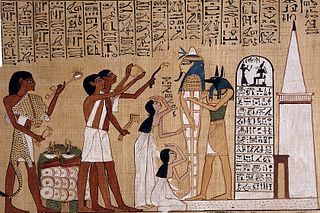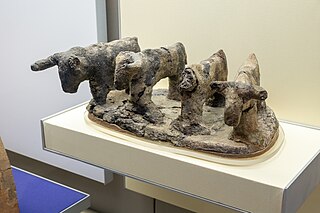
Aegean civilization is a general term for the Bronze Age civilizations of Greece around the Aegean Sea. There are three distinct but communicating and interacting geographic regions covered by this term: Crete, the Cyclades and the Greek mainland. Crete is associated with the Minoan civilization from the Early Bronze Age. The Cycladic civilization converges with the mainland during the Early Helladic ("Minyan") period and with Crete in the Middle Minoan period. From c. 1450 BC, the Greek Mycenaean civilization spreads to Crete, probably by military conquest. The earlier Aegean farming populations of Neolithic Greece brought agriculture westward into Europe before 5,000 BC.

The British Museum is a public museum dedicated to human history, art and culture located in the Bloomsbury area of London. Its permanent collection of eight million works is the largest in the world. It documents the story of human culture from its beginnings to the present. The British Museum was the first public national museum to cover all fields of knowledge.

Canopic jars are containers that were used by the ancient Egyptians during the mummification process, to store and preserve the viscera of their owner for the afterlife. The earliest and most common versions were made from stone, but later styles were carved from wood. The ritual use of the jars dates back as far as the Old Kingdom and stayed in practice until the Late Period or the Ptolemaic Period, by which time the viscera were simply wrapped and placed with the body. Canopic jars of the Old Kingdom were rarely inscribed and had a plain lid, but by the Middle Kingdom inscriptions became more usual, and the lids were often in the form of human heads. By the Nineteenth Dynasty each of the four lids depicted one of the four sons of Horus, actings as guardians for the respective organ in their jar.

African art describes the modern and historical paintings, sculptures, installations, and other visual culture from native or indigenous Africans and the African continent. The definition may also include the art of the African diasporas, such as: African-American, Caribbean or art in South American societies inspired by African traditions. Despite this diversity, there are unifying artistic themes present when considering the totality of the visual culture from the continent of Africa.

Ancient art refers to the many types of art produced by the advanced cultures of ancient societies with different forms of writing, such as those of ancient China, India, Mesopotamia, Persia, Palestine, Egypt, Greece, and Rome. The art of pre-literate societies is normally referred to as prehistoric art and is not covered here. Although some pre-Columbian cultures developed writing during the centuries before the arrival of Europeans, on grounds of dating these are covered at pre-Columbian art and articles such as Maya art, Aztec art, and Olmec art.

The ancient Egyptians had an elaborate set of funerary practices that they believed were necessary to ensure their immortality after death. These rituals included mummifying the body, casting magic spells, and burials with specific grave goods thought to be needed in the afterlife.

Ancient Egyptian art refers to art produced in ancient Egypt between the 6th millennium BC and the 4th century AD, spanning from Prehistoric Egypt until the Christianization of Roman Egypt. It includes paintings, sculptures, drawings on papyrus, faience, jewelry, ivories, architecture, and other art media. It was a conservative tradition whose style changed very little over time. Much of the surviving examples comes from tombs and monuments, giving insight into the ancient Egyptian afterlife beliefs.

The necropolis of Draʻ Abu el-Naga' is located on the West Bank of the Nile at Thebes, Egypt, just by the entrance of the dry bay that leads up to Deir el-Bahari and north of the necropolis of el-Assasif. The necropolis is located near the Valley of the Kings.
The Gerzeh culture, also called Naqada II, refers to the archaeological stage at Gerzeh, a prehistoric Egyptian cemetery located along the west bank of the Nile. The necropolis is named after el-Girzeh, the nearby contemporary town in Egypt. Gerzeh is situated only several miles due east of the oasis of Faiyum.

Egyptian faience is a sintered-quartz ceramic material from Ancient Egypt. The sintering process "covered [the material] with a true vitreous coating" as the quartz underwent vitrification, creating a bright lustre of various colours "usually in a transparent blue or green isotropic glass". Its name in the Ancient Egyptian language was tjehenet, and modern archeological terms for it include sintered quartz, glazed frit, and glazed composition. Tjehenet is distinct from the crystalline pigment Egyptian blue, for which it has sometimes incorrectly been used as a synonym.

Most African sculpture was historically in wood and other organic materials that have not survived from earlier than at most a few centuries ago; older pottery figures are found from a number of areas. Masks are important elements in the art of many peoples, along with human figures, often highly stylized. There is a vast variety of styles, often varying within the same context of origin depending on the use of the object, but wide regional trends are apparent; sculpture is most common among "groups of settled cultivators in the areas drained by the Niger and Congo rivers" in West Africa. Direct images of African deities are relatively infrequent, but masks in particular are or were often made for traditional African religious ceremonies; today many are made for tourists as "airport art". African masks were an influence on European Modernist art, which was inspired by their lack of concern for naturalistic depiction.

The Gebelein predynastic mummies are six naturally mummified bodies, dating to approximately 3400 BC from the Late Predynastic period of Ancient Egypt. They were the first complete predynastic bodies to be discovered. The well-preserved bodies were excavated at the end of the nineteenth century by Wallis Budge, the British Museum Keeper for Egyptology, from shallow sand graves near Gebelein in the Egyptian desert.

Funerary art is any work of art forming, or placed in, a repository for the remains of the dead. The term encompasses a wide variety of forms, including cenotaphs, tomb-like monuments which do not contain human remains, and communal memorials to the dead, such as war memorials, which may or may not contain remains, and a range of prehistoric megalithic constructs. Funerary art may serve many cultural functions. It can play a role in burial rites, serve as an article for use by the dead in the afterlife, and celebrate the life and accomplishments of the dead, whether as part of kinship-centred practices of ancestor veneration or as a publicly directed dynastic display. It can also function as a reminder of the mortality of humankind, as an expression of cultural values and roles, and help to propitiate the spirits of the dead, maintaining their benevolence and preventing their unwelcome intrusion into the lives of the living.

Hornedjitef was an ancient Egyptian priest in the Temple of Amun at Karnak during the reign of Ptolemy III. He is known from his elaborate coffins, mummy mask and mummy, dating from the Early Ptolemaic Period and excavated from Asasif, Thebes, Egypt, which are all held in the British Museum. These related objects were chosen as the first of the hundred objects selected by British Museum Director Neil MacGregor in the 2010 BBC Radio 4 series A History of the World in 100 Objects.

The Abydos boats are the remnants of a group of ancient royal Egyptian ceremonial boats found at an archaeological site in Abydos, Egypt. Discovered in 1991, excavation of the Abydos boats began in 2000 at which time fourteen boats were identified. They are located alongside the massive mudbrick structure known as Shunet El Zebib, attributed to the 2nd Dynasty Pharaoh Khasekhemwy. Shunet El Zebib is one of several such "enclosure wall" constructions at this site dating back to the 1st Dynasty, and is located nearly one mile from the early dynastic royal cemetery of Umm El Qa'ab.

The ancient Egyptians regarded beauty as a sign of holiness. Everything they used had a spiritual aspect to it, including cosmetics. Both men and women wore makeup. Traders traded makeup often, especially in the upper classes. In tombs, cosmetic palettes were found buried in gold with the deceased as grave goods, which further emphasized the idea that cosmetics were not only used for aesthetic purposes but rather magical and religious purposes.

Ceramic art is art made from ceramic materials, including clay. It may take varied forms, including artistic pottery, including tableware, tiles, figurines and other sculpture. As one of the plastic arts, ceramic art is a visual art. While some ceramics are considered fine art, such as pottery or sculpture, most are considered to be decorative, industrial or applied art objects. Ceramic art can be created by one person or by a group, in a pottery or a ceramic factory with a group designing and manufacturing the artware.
Mastaba S3504 is a large mastaba tomb located in the Saqqara necropolis in Lower Egypt. It was built during the reign of the ancient Egyptian Pharaoh Djet, in the First Dynasty, shortly after 3000 BC. It is one of the largest mastabas from this dynasty. The building was excavated in 1953 by Walter Bryan Emery.

El-Amrah is a site about 120 km (75 mi) south of Badari, Upper Egypt.

Ancient Egyptian pottery includes all objects of fired clay from ancient Egypt. First and foremost, ceramics served as household wares for the storage, preparation, transport, and consumption of food, drink, and raw materials. Such items include beer and wine mugs and water jugs, but also bread moulds, fire pits, lamps, and stands for holding round vessels, which were all commonly used in the Egyptian household. Other types of pottery served ritual purposes. Ceramics are often found as grave goods.


















